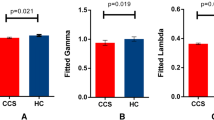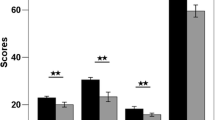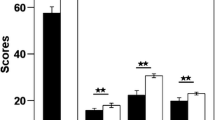Abstract
Objectives
The study aimed to explore the effects of codeine-containing cough syrup (CCS) exposure on cortical morphology and the relationship between cortical characteristics and CCS dependence.
Methods
Cortical morphometry based on Computational Anatomy Toolbox (CAT12) was used to compare changes in sulcal depth, gyrification, and cortical thickness of the cerebral cortex from 40 CCS users and 40 healthy controls (HCs) with two-sample t tests (p < 0.05, multiple comparison corrected). Relationships between abnormal cortical morphological changes and the duration of CCS use, impulsivity traits, and age of first use were investigated with correlation analysis (p < 0.05, uncorrected).
Results
CCS users exhibited significantly increased sulcal depth in the bilateral insula, bilateral lingual, bilateral superior frontal, right precuneus, and right middle frontal regions; increased gyrification in the right precentral cortex; and increased cortical thickness in the bilateral precentral, bilateral precuneus, and right superior temporal cortices compared to HCs. In addition, we found significant correlations between the bilateral insula, right superior frontal cortex, and right precentral gyrus and Barratt Impulsiveness Scale (BIS) total scores.
Conclusions
Chronic CCS abuse may be associated with aberrant sulcal depth, gyrification, and cortical thickness. These morphological changes might serve as an underlying neurobiological mechanism of impulsive behavior in the CCS users.
Key Points
• Cortical morphological changes were detected in CCS users.
• Increased sulcal depth, gyrification, and cortical thickness of some regions were found in the CCS users.
• Positive correlations between cortical morphological changes and BIS total scores were identified.


Similar content being viewed by others
Abbreviations
- BIS:
-
Barratt Impulsiveness Scale
- CAT12:
-
Computational Anatomy Toolbox
- CCS:
-
Codeine-containing cough syrup
- HCs:
-
Healthy controls
- INS:
-
Insula
- LING:
-
Lingual
- MFC:
-
Middle frontal cortex
- PBT:
-
Projection-based thickness
- PCUN:
-
Precuneus
- PFC:
-
Prefrontal cortex
- PreCG:
-
Precentral gyrus
- SFC:
-
Superior frontal cortex
- STC:
-
Superior temporal cortex
- TIV:
-
Total intracranial volume
References
Hutchings HA, Eccles R (1994) The opioid agonist codeine and antagonist naltrexone do not affect voluntary suppression of capsaicin induced cough in healthy subjects. Eur Respir J 7:715–719
Shek DT, Lam CM (2006) Adolescent cough medicine abuse in Hong Kong: implications for the design of positive youth development programs in Hong Kong. Int J Adolesc Med Health 18:493–503
Vree TB, van Dongen RT, Koopman-Kimenai PM (2000) Codeine analgesia is due to codeine-6-glucuronide, not morphine. Int J Clin Pract 54:395–398
Daumann J, Koester P, Becker B et al (2011) Medial prefrontal gray matter volume reductions in users of amphetamine-type stimulants revealed by combined tract-based spatial statistics and voxel-based morphometry. Neuroimage 54:794–801
Brody AL, Mandelkern MA, Jarvik ME et al (2004) Differences between smokers and nonsmokers in regional gray matter volumes and densities. Biol Psychiatry 55:77–84
Ersche KD, Jones PS, Williams GB, Turton AJ, Robbins TW, Bullmore ET (2012) Abnormal brain structure implicated in stimulant drug addiction. Science 335:601–604
Ersche KD, Barnes A, Jones PS, Morein-Zamir S, Robbins TW, Bullmore ET (2011) Abnormal structure of frontostriatal brain systems is associated with aspects of impulsivity and compulsivity in cocaine dependence. Brain 134:2013–2024
Li M, Tian J, Zhang R et al (2014) Abnormal cortical thickness in heroin-dependent individuals. Neuroimage 88:295–307
Meunier D, Ersche KD, Craig KJ et al (2012) Brain functional connectivity in stimulant drug dependence and obsessive-compulsive disorder. Neuroimage 59:1461–1468
Daglish MR, Weinstein A, Malizia AL et al (2003) Functional connectivity analysis of the neural circuits of opiate craving: “more” rather than “different”? Neuroimage 20:1964–1970
Qiu YW, Han LJ, Lv XF et al (2011) Regional homogeneity changes in heroin-dependent individuals: resting-state functional MR imaging study. Radiology 261:551–559
Lopez-Larson MP, Bogorodzki P, Rogowska J et al (2011) Altered prefrontal and insular cortical thickness in adolescent marijuana users. Behav Brain Res 220:164–172
McQueeny T, Padula CB, Price J, Medina KL, Logan P, Tapert SF (2011) Gender effects on amygdala morphometry in adolescent marijuana users. Behav Brain Res 224:128–134
Makris N, Gasic GP, Kennedy DN et al (2008) Cortical thickness abnormalities in cocaine addiction—a reflection of both drug use and a pre-existing disposition to drug abuse? Neuron 60:174–188
Moreno-López L, Catena A, Fernández-Serrano MJ et al (2012) Trait impulsivity and prefrontal gray matter reductions in cocaine dependent individuals. Drug Alcohol Depend 125:208–214
Qiu YW, Su HH, Lv XF, Jiang GH (2015) Abnormal white matter integrity in chronic users of codeine-containing cough syrups: a tract-based spatial statistics study. AJNR Am J Neuroradiol 36:50–56
Hou H, Yin S, Jia S et al (2011) Decreased striatal dopamine transporters in codeine-containing cough syrup abusers. Drug Alcohol Depend 118:148–151
Qiu YW, Lv XF, Jiang GH et al (2014) Reduced ventral medial prefrontal cortex (vmPFC) volume and impaired vmPFC-default mode network integration in codeine-containing cough syrups users. Drug Alcohol Depend 134:314–321
Lin HC, Wang PW, Wu HC, Ko CH, Yang YH, Yen CF (2018) Altered gray matter volume and disrupted functional connectivity of dorsolateral prefrontal cortex in men with heroin dependence. Psychiatry Clin Neurosci 72:435–444
Tamnes CK, Ostby Y, Fjell AM, Westlye LT, Due-Tønnessen P, Walhovd KB (2010) Brain maturation in adolescence and young adulthood: regional age-related changes in cortical thickness and white matter volume and microstructure. Cereb Cortex 20:534–548
Gautam P, Anstey KJ, Wen W, Sachdev PS, Cherbuin N (2015) Cortical gyrification and its relationships with cortical volume, cortical thickness, and cognitive performance in healthy mid-life adults. Behav Brain Res 287:331–339
Wei Q, Li M, Kang Z et al (2015) ZNF804A rs1344706 is associated with cortical thickness, surface area, and cortical volume of the unmedicated first episode schizophrenia and healthy controls. Am J Med Genet B Neuropsychiatr Genet 168B:265–273
Pontious A, Kowalczyk T, Englund C, Hevner RF (2008) Role of intermediate progenitor cells in cerebral cortex development. Dev Neurosci 30:24–32
Li Y, Yuan K, Cai C et al (2015) Reduced frontal cortical thickness and increased caudate volume within fronto-striatal circuits in young adult smokers. Drug Alcohol Depend 151:211–219
Kühn S, Schubert F, Gallinat J (2010) Reduced thickness of medial orbitofrontal cortex in smokers. Biol Psychiatry 68:1061–1065
Jacobus J, Squeglia LM, Sorg SF, Nguyen-Louie TT, Tapert SF (2014) Cortical thickness and neurocognition in adolescent marijuana and alcohol users following 28 days of monitored abstinence. J Stud Alcohol Drugs 75:729–743
Migliorini R, Moore EM, Glass L et al (2015) Anterior cingulate cortex surface area relates to behavioral inhibition in adolescents with and without heavy prenatal alcohol exposure. Behav Brain Res 292:26–35
Qiu YW, Lv XF, Jiang GH et al (2017) Potential gray matter unpruned in adolescents and young adults dependent on dextromethorphan-containing cough syrups: evidence from cortical and subcortical study. Brain Imaging Behav 11:1470–1478
Im K, Lee JM, Yoon U et al (2006) Fractal dimension in human cortical surface: multiple regression analysis with cortical thickness, sulcal depth, and folding area. Hum Brain Mapp 27:994–1003
Hogstrom LJ, Westlye LT, Walhovd KB, Fjell AM (2013) The structure of the cerebral cortex across adult life: age-related patterns of surface area, thickness, and gyrification. Cereb Cortex 23:2521–2530
Patton JH, Stanford MS, Barratt ES (1995) Factor structure of the Barratt Impulsiveness Scale. J Clin Psychol 51:768–774
Dahnke R, Yotter RA, Gaser C (2013) Cortical thickness and central surface estimation. Neuroimage 65:336–348
Luders E, Thompson PM, Narr KL, Toga AW, Jancke L, Gaser C (2006) A curvature-based approach to estimate local gyrification on the cortical surface. Neuroimage 29:1224–1230
Baler RD, Volkow ND (2006) Drug addiction: the neurobiology of disrupted self-control. Trends Mol Med 12:559–566
Asplund CL, Todd JJ, Snyder AP, Marois R (2010) A central role for the lateral prefrontal cortex in goal-directed and stimulus-driven attention. Nat Neurosci 13:507–512
Benoit RG, Gilbert SJ, Frith CD, Burgess PW (2012) Rostral prefrontal cortex and the focus of attention in prospective memory. Cereb Cortex 22:1876–1886
Walton ME, Devlin JT, Rushworth MF (2004) Interactions between decision making and performance monitoring within prefrontal cortex. Nat Neurosci 7:1259–1265
Gläscher J, Adolphs R, Damasio H et al (2012) Lesion mapping of cognitive control and value-based decision making in the prefrontal cortex. Proc Natl Acad Sci U S A 109:14681–14686
McNamee D, Rangel A, O’Doherty JP (2013) Category-dependent and category-independent goal-value codes in human ventromedial prefrontal cortex. Nat Neurosci 16:479–485
Galynker II, Eisenberg D, Matochik JA et al (2007) Cerebral metabolism and mood in remitted opiate dependence. Drug Alcohol Depend 90:166–174
Crews FT, Braun CJ, Hoplight B, Switzer RC 3rd, Knapp DJ (2000) Binge ethanol consumption causes differential brain damage in young adolescent rats compared with adult rats. Alcohol Clin Exp Res 24:1712–1723
Squeglia LM, Jacobus J, Tapert SF (2009) The influence of substance use on adolescent brain development. Clin EEG Neurosci 40:31–38
Ritz MC, Lamb RJ, Goldberg SR, Kuhar MJ (1987) Cocaine receptors on dopamine transporters are related to self-administration of cocaine. Science 237:1219–1223
Volkow ND, Fowler JS, Wang GJ (1999) Imaging studies on the role of dopamine in cocaine reinforcement and addiction in humans. J Psychopharmacol 13:337–345
Gogtay N, Giedd JN, Lusk L et al (2004) Dynamic mapping of human cortical development during childhood through early adulthood. Proc Natl Acad Sci U S A 101:8174–8179
Volkow ND, Fowler JS, Wang GJ, Goldstein RZ (2002) Role of dopamine, the frontal cortex and memory circuits in drug addiction: insight from imaging studies. Neurobiol Learn Mem 78:610–624
Tisserand DJ, Pruessner JC, Sanz Arigita EJ et al (2002) Regional frontal cortical volumes decrease differentially in aging: an MRI study to compare volumetric approaches and voxel-based morphometry. Neuroimage 17:657–669
Raz N, Lindenberger U, Rodrigue KM et al (2005) Regional brain changes in aging healthy adults: general trends, individual differences and modifiers. Cereb Cortex 15:1676–1689
Sowell ER, Thompson PM, Tessner KD, Toga AW (2001) Mapping continued brain growth and gray matter density reduction in dorsal frontal cortex: inverse relationships during postadolescent brain maturation. J Neurosci 21:8819–8829
Sowell ER, Thompson PM, Leonard CM, Welcome SE, Kan E, Toga AW (2004) Longitudinal mapping of cortical thickness and brain growth in normal children. J Neurosci 24:8223–8231
Volkow ND, Fowler JS, Wang GJ, Swanson JM (2004) Dopamine in drug abuse and addiction: results from imaging studies and treatment implications. Mol Psychiatry 9:557
Volkow ND, Wang GJ, Tomasi D, Baler RD (2013) Unbalanced neuronal circuits in addiction. Curr Opin Neurobiol 23:639–648
Hester R, Nestor L, Garavan H (2009) Impaired error awareness and anterior cingulate cortex hypoactivity in chronic cannabis users. Neuropsychopharmacology 34:2450–2458
Garavan H (2010) Insula and drug cravings. Brain Struct Funct 214:593–601
Clark L, Bechara A (2015) Commentary on Abdolahi et al (2015): Isolating the role of the insula in drug cravings. Addiction 110:2004–2005
Menon V, Uddin LQ (2010) Saliency, switching, attention and control: a network model of insula function. Brain Struct Funct 214:655–667
Contreras M, Ceric F, Torrealba F (2007) Inactivation of the interoceptive insula disrupts drug craving and malaise induced by lithium. Science 318:655–658
Naqvi NH, Rudrauf D, Damasio H, Bechara A (2007) Damage to the insula disrupts addiction to cigarette smoking. Science 315:531–534
Sridharan D, Levitin DJ, Menon V (2008) A critical role for the right fronto-insular cortex in switching between central-executive and default-mode networks. Proc Natl Acad Sci U S A 105:12569–12574
Palaniyappan L, Liddle PF (2012) Does the salience network play a cardinal role in psychosis? An emerging hypothesis of insular dysfunction. J Psychiatry Neurosci 37:17–27
Naqvi NH, Bechara A (2010) The insula and drug addiction: an interoceptive view of pleasure, urges, and decision-making. Brain Struct Funct 214:435–450
Haldane M, Cunningham G, Androutsos C, Frangou S (2008) Structural brain correlates of response inhibition in bipolar disorder I. J Psychopharmacol 22:138–143
Jiang GH, Qiu YW, Zhang XL et al (2011) Amplitude low-frequency oscillation abnormalities in the heroin users: a resting state fMRI study. Neuroimage 57:149–154
Chang L, Yakupov R, Cloak C, Ernst T (2006) Marijuana use is associated with a reorganized visual-attention network and cerebellar hypoactivation. Brain 129:1096–1112
Im K, Lee JM, Seo SW, Kim SH, Kim SI, Na DL (2008) Sulcal morphology changes and their relationship with cortical thickness and gyral white matter volume in mild cognitive impairment and Alzheimer’s disease. Neuroimage 43:103–113
Kochunov P, Mangin JF, Coyle T et al (2005) Age-related morphology trends of cortical sulci. Hum Brain Mapp 26:210–220
Kochunov P, Thompson PM, Coyle TR et al (2008) Relationship among neuroimaging indices of cerebral health during normal aging. Hum Brain Mapp 29:36–45
Thatcher DL, Pajtek S, Chung T, Terwilliger RA, Clark DB (2010) Gender differences in the relationship between white matter organization and adolescent substance use disorders. Drug Alcohol Depend 110:55–61
Funding
The authors state that this work has not received any funding.
Author information
Authors and Affiliations
Corresponding author
Ethics declarations
Guarantor
The scientific guarantor of this publication is Guihua Jiang.
Conflict of interest
The authors declare that they have no competing interests.
Statistics and biometry
No complex statistical methods were necessary for this paper.
Informed consent
Written informed consent was obtained from all subjects (patients) in this study.
Ethical approval
Institutional review board approval was obtained.
Study subjects or cohorts overlap
No study subjects or cohorts have been previously reported.
Methodology
• prospective
• cross-sectional study
• performed at one institution
Additional information
Publisher’s note
Springer Nature remains neutral with regard to jurisdictional claims in published maps and institutional affiliations.
Rights and permissions
About this article
Cite this article
Li, M., Hua, K., Li, S. et al. Cortical morphology of chronic users of codeine-containing cough syrups: association with sulcal depth, gyrification, and cortical thickness. Eur Radiol 29, 5901–5909 (2019). https://doi.org/10.1007/s00330-019-06165-0
Received:
Revised:
Accepted:
Published:
Issue Date:
DOI: https://doi.org/10.1007/s00330-019-06165-0




